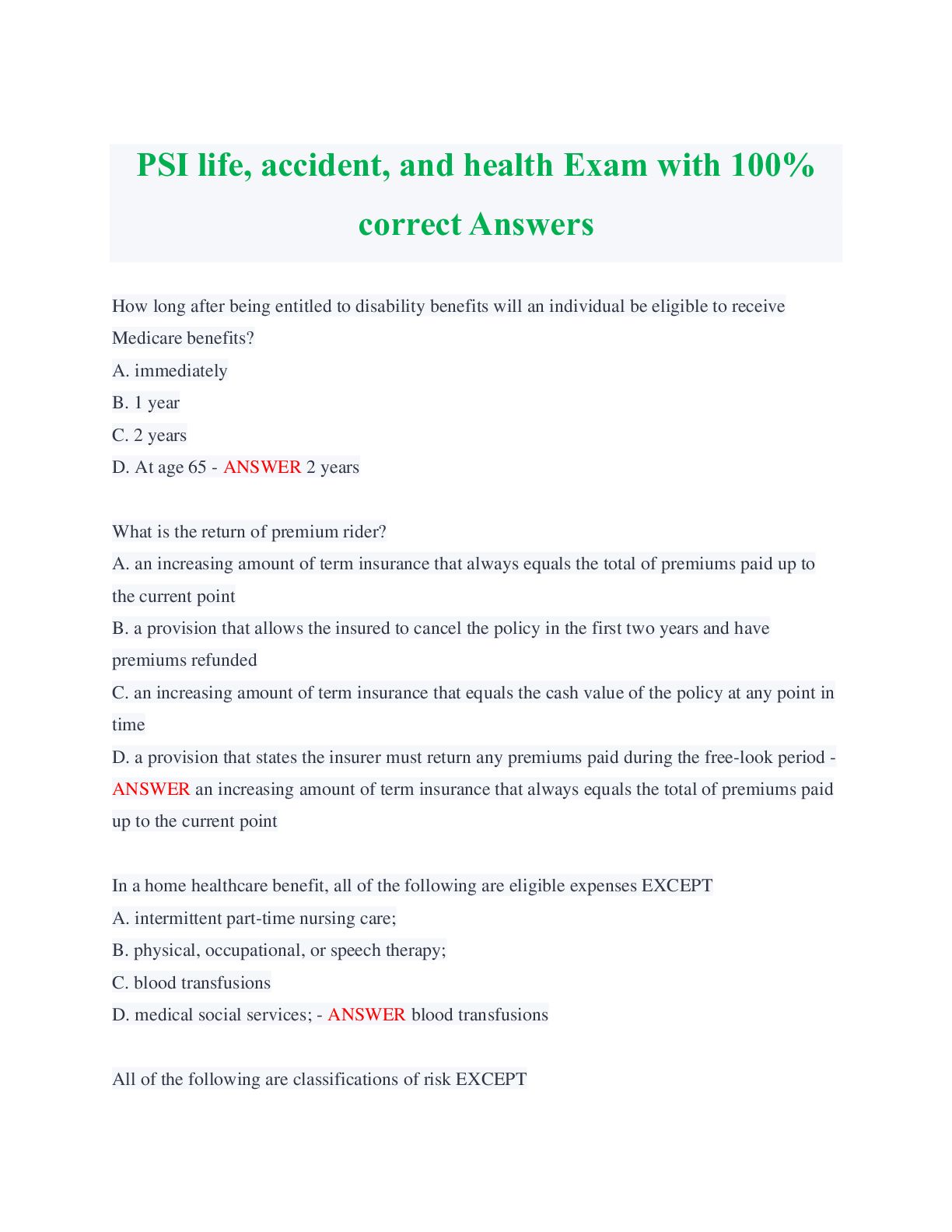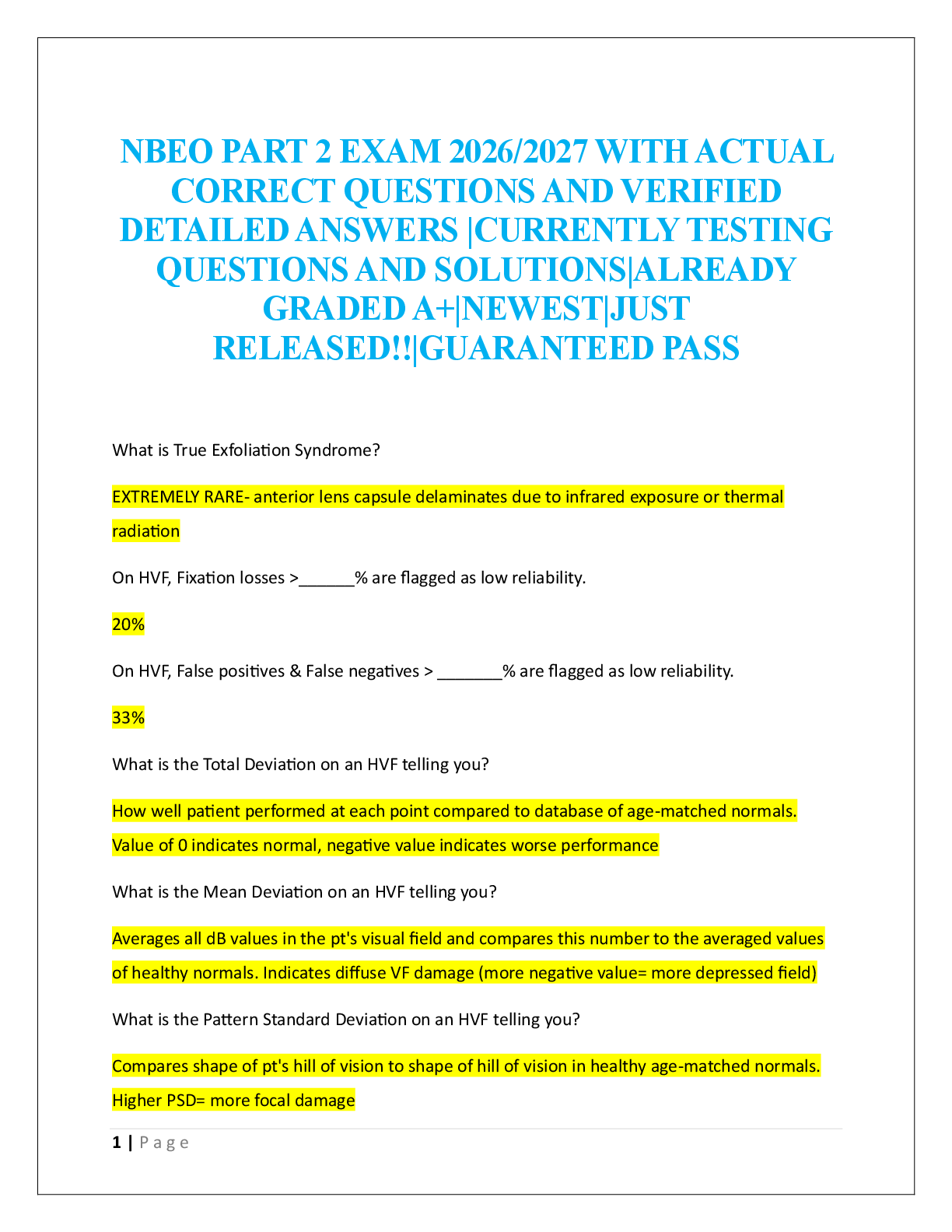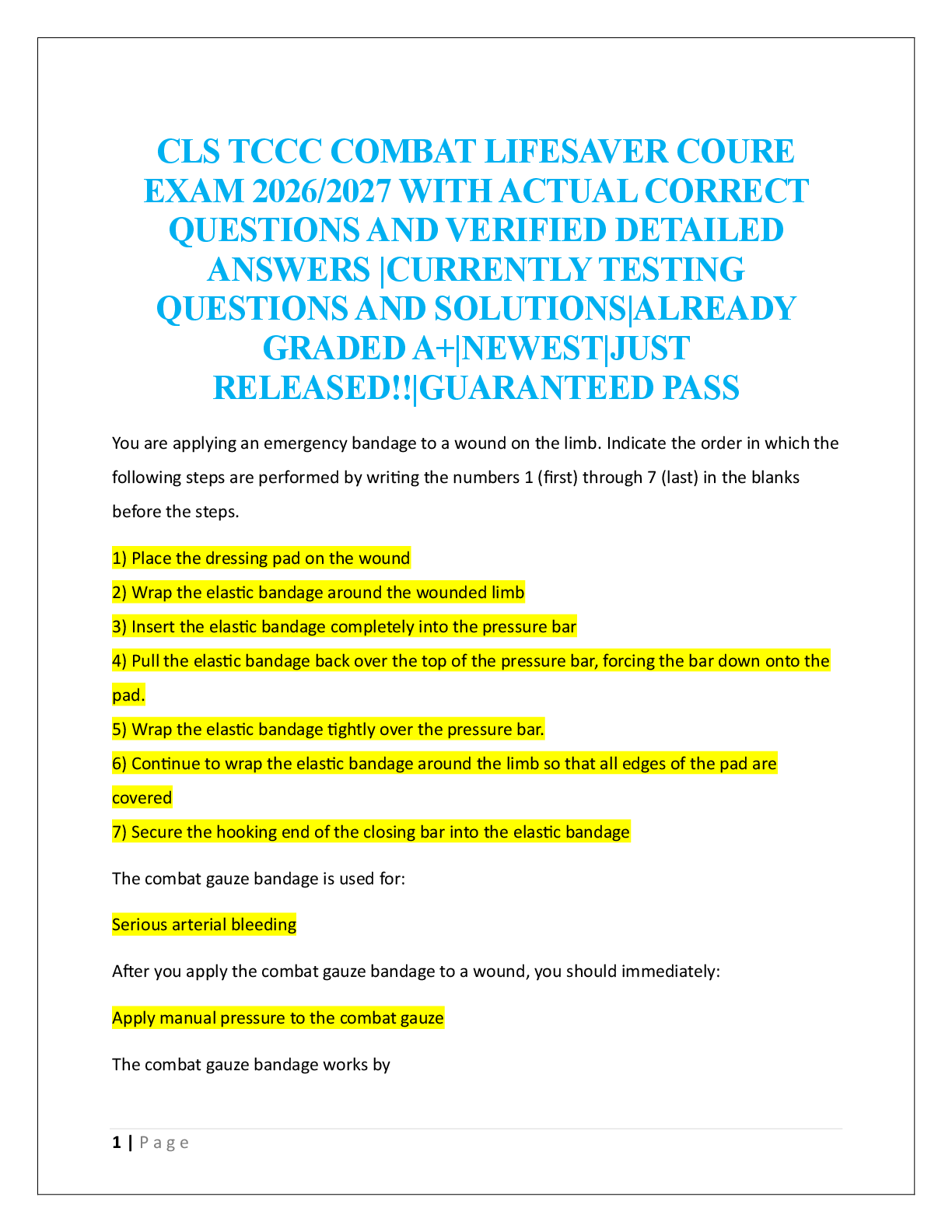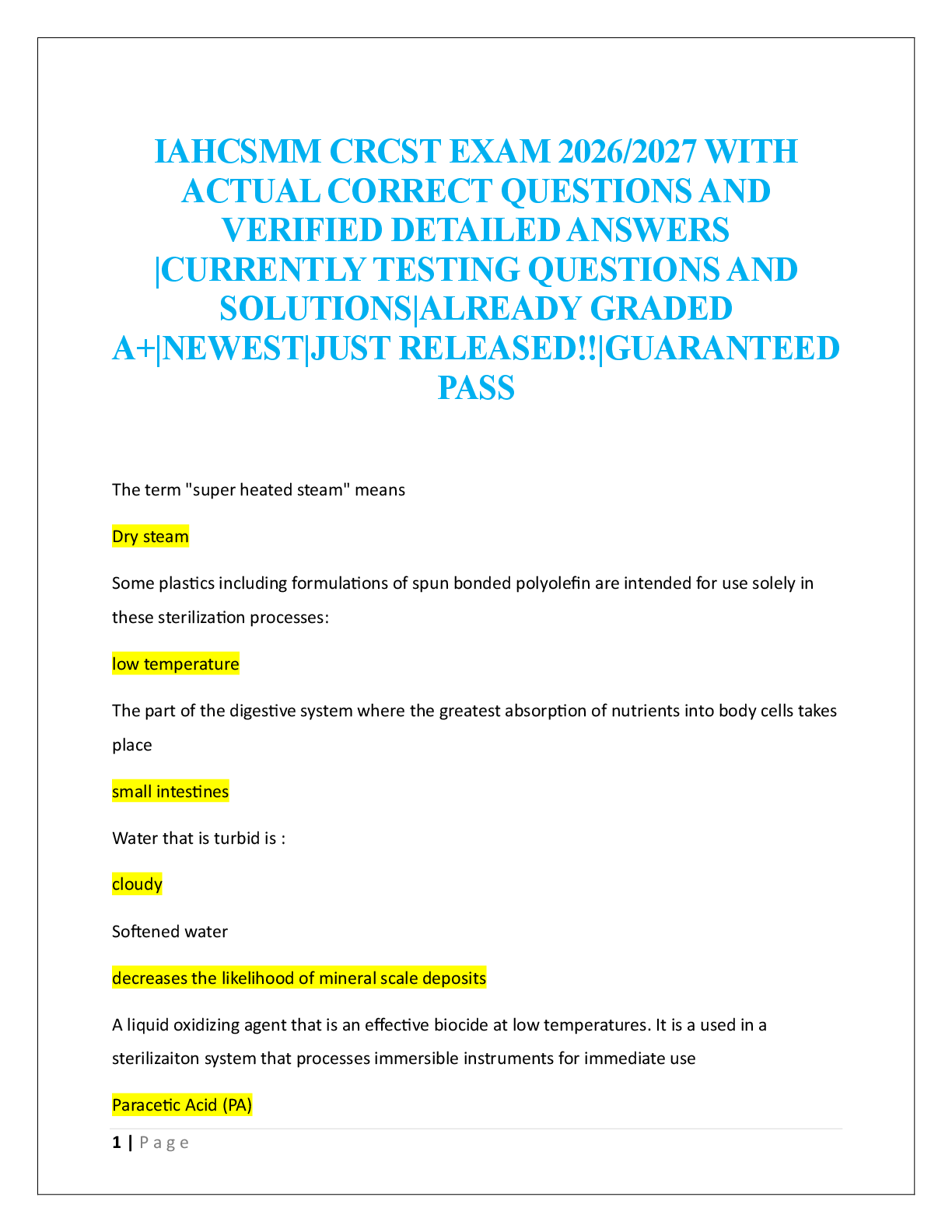ANP 1105 University of Ottawa Midterm Exam 1 Fall 2022
Document Content and Description Below
Ribosome Ans- Which of the following is NOT one of the three major components of a typical eukaryotic cell? a) Cytoplasm b) Ribosome c) Plasma Membrane d) Nucleus Lysosome Ans- Which of the foll ... owing acts as the digestive system of the cell, breaking down materials? a) Ribosome b) Nucleus c) Lysosome d) Endoplasmic Reticulum In the DNA within the cell's nucleus Ans- Where in a typical eukaryote cell would you expect to find genes? a) In chromosomes within the cytosol b) In the DNA within the cell's nucleus c) In the nucleolus within the nucleus d) In the chromatin within the cell's cytoplasm? A Ans- Which set of membrane proteins in the figure depicts the transport of solute molecules? Mitochondrion Ans- The figure is of which organelle? Enzymes involved in cellular respiration Ans- The folded membranes indicated by B are the sites of _________. a) Intracellular digestion b) Enzymes involved in cellular respiration c) Phagocytosis d) Endocytosis Hydrolytic enzymes (lysosomes) Ans- The membrane-bound compartment indicated by structure D contains which of the following? a) nucleic acids b) ribosomes c) oxidases and catalases d) hydrolytic enzymes Synthesis of secreted proteins Ans- What major function occurs on the specific membranes indicated by A? a) digestion of food particles b) production of most of the cell's ATP c) replication of DNA d) synthesis of secreted proteins Ribosomes Ans- Which organelle is responsible for synthesizing proteins? a) Golgi apparatus b) mitochondria c) smooth ER d) ribosomes They contain powerful enzymes called acid hydrolases Ans- Which of the following is NOT a characteristic of peroxisomes? a) they aid in the neutralization of dangerous free radicals b) they contain powerful enzymes called catalases c) They contain powerful enzymes called oxidases d) They contain powerful enzymes called acid hydolases They are whiplike, motile cellular extensions that occur in large numbers on the exposed surfaces of certain cells. Ans- Which of the following is characteristic of cilia? a) They move substances in any direction across cell surfaces. b) They are used for cellular adhesion. c) They are whiplike, motile cellular extensions that occur in large numbers on the exposed surfaces of certain cells. d) They are substantially longer than flagella, and are most easily seen in human sperm cells. True. Lysosomes are large and abundant within phagocytes, the cells that dispose of invading bacteria and cell debris. Lysosomal enzymes can digest almost all kinds of biological molecules. They work best in acidic conditions and so are called acid hydrolases. Ans- Lysosomes perform digestive functions within a cell. T or F the enzyme functions only in lysosomes and not in the blood Ans- Babies with TaySachs disease cannot be treated by injecting the missing enzyme into their blood because_________. a) the enzyme is a protein and, therefore, is not soluble in the blood b) the enzyme is a protein that is digested by glycolipids in the blood c) blood is not capable of delivering substances directly to nerve cells d) the enzyme functions only in lysosomes and not in the blood the smooth ER Ans- In certain kinds of muscle cells, calcium ions are stored in ________. a) the rough ER b) the smooth ER c) the cytoplasm d) both smooth and rough ER Motor proteins Ans- What moves cell organelles from one location to another inside a cell? a) Microfilaments b) Intermediate filaments c) Motor proteins d) Microtubules centriole Ans- The electron microscope has revealed that one of the components within the cell consists of pinwheel array of 9 triplets of microtubules arranged to form a hollow tube. This structure is a ________. a) centriole b) chromosome c) centrosome d) ribosome melanin Ans- Which of these is an inclusion, not an organelle? a) microtubule b) cilia c) lysosome d) melanin protein synthesis in conjunction with ribosomes Ans- Which of the following is NOT a function of the smooth endoplasmic reticulum? a) lipid metabolism and cholesterol synthesis b) protein synthesis in conjunction with ribosomes c) steroid-based hormone synthesis d) breakdown of stored glycogen to form free glucose contain some of the DNA and RNA code necessary for their own function AnsMitochondria ________. a) synthesize proteins for use outside the cell b) are single-membrane structures involved in the breakdown of ATP c) are always the same shape d) contain some of the DNA and RNA code necessary for their own function false; integral cell membrane proteins are also synthesized this way Ans- Ribosomes, endoplasmic reticulum, and the Golgi apparatus functionally act in sequence to synthesize and modify proteins for secretory use (export) only, never for use by the cell. This statement is ________. a) false; lipids, not proteins, are synthesized this way b) false; proteins thus manufactured are for use inside the cell only c) false; integral cell membrane proteins are also synthesized this way d) true are able to detoxify substances by enzymatic action Ans- Peroxisomes ________. a) function to digest particles ingested by endocytosis b) are able to detoxify substances by enzymatic action c) sometimes function as secretory vesicles d) are also called microbodies, and contain acid hydrolases water Ans- The main component of the cytosol is ________. a) sugars b) water c) salts d) proteins Mitochondria are the site of the majority of ATP production because of the specialized enzymes on their cristae. Ans- Which cell organelle provides the majority of the ATP needed by the cell to carry out its metabolic reactions? a) Golgi apparatus b) ribosome c) mitochondrion d) lysosome histone Ans- What type of protein is indicated by the arrow? a) histone b) collagen c) actin d) hemoglobin is the site of ribosome assembly in a cell Ans- The nucleolus ________. a) is a dark-staining spherical body found within the mitochondria b) is the site of lipid production in a cell c) is the site of ribosome assembly in a cell d) is the primary site of protein synthesis junctions among epithelial cells lining the digestive tract Ans- Which of the following describes tight junctions? a) junctions among epithelial cells lining the digestive tract b) junctions within electrically excitable tissues, such as the heart and smooth muscle c) cell junctions in areas that are subjected to great mechanical stress, such as the skin and heart muscles d) junctions where cells are held together by cadherins all of the above Ans- Which of the following molecules might change over time in a cancer cell? a) membrane glycolipids b) membrane glycoproteins c) glycocalyx sugars d) all of the above desmosomes Ans- Which type of cell junction acts as anchors and distributes tension through a cellular sheet and reduces the chance of tearing when it is subjected to great mechanical stress? a) gap junctions b) connexons c) desmosomes d) tight junctions glycolipids in the glycocalyx Ans- Which of the following is not a factor that binds cells together? a) glycolipids in the glycocalyx b) special membrane junctions c) glycoproteins in the glycocalyx d) wavy contours of the membranes of adjacent cells Phospholipids form a bilayer that is largely impermeable to water-soluble molecules. Ans- Which of the following is a principle of the fluid mosaic model of cell membrane structure? a) Phospholipids form a bilayer that is largely impermeable to water-soluble molecules. b) The lipid bilayer is a solid at body temperature, thus protecting the cell. c) Phospholipids consist of a polar head and a nonpolar tail made of three fatty acid chains. d) All proteins associated with the cell membrane are contained in a fluid layer on the outside of the cell. It is a dynamic fluid structure that is in constant flux. Ans- Which of the following statements correctly describes the plasma membrane? a) It is a solid structure formed by phospholipids and cholesterol designed to be stable against pressure. b) It is a dynamic fluid structure that is in constant flux. c) It is a flexible protein barrier supported by cholesterol rods. d) It is a unique, solid barrier custom designed for each type of cell. phospholipids Ans- Which of the following is the main component of the cell membrane? a) carbohydrates b) phospholipids c) water d) cholesterol Semipermeable Ans- Which of the following is a characteristic of the cell membrane? a) fully permeable b) impermeable c) semipermeable d) not permeable forming the entire glycocalyx Ans- Which of the following is not a major function of proteins in the cell membrane? a) forming the entire glycocalyx b) forming channels c) anchoring cells to other structures d) acting as receptors phosphate heads of phospholipids Ans- What part of a cell membrane is usually in contact with the interstitial fluid? a) phosphate heads of phospholipids b) hydrophobic molecules c) fatty acid tails d) cholesterol molecules move through transport proteins that have been activated by ATP Ans- A primary active transport process is one in which __________. a) molecules move through transport proteins that have been activated by ATP b) molecules pass directly through the phospholipid bilayer of the plasma membrane c) the plasma membrane folds inward to form a vesicle containing extracellular material d) molecules move across the plasma membrane without an input of energy e) an intracellular vesicle fuses with the plasma membrane and releases its contents to the extracellular fluid Facilitated diffusion is a passive transport process during which molecules move down their concentration gradients through transport proteins. Ans- Some transport processes use transport proteins in the plasma membrane, but do not require ATP. This type of transport is known as _____. a) facilitated diffusion b) active transport c) simple diffusion d) exocytosis e) endocytosis facilitated diffusion Ans- The majority of water molecules moving across plasma membranes by osmosis do so via a process that is most similar to ____. a) cotransport b) active transport c) simple diffusion d) a process that requires energy from the cell e) facilitated diffusion primary active transport Ans- The sodium-potassium pump uses ATP to move sodium and potassium ions across the plasma membrane. This statement describes _____. a) secondary active transport b) simple diffusion c) facilitated diffusion d) exocytosis e) primary active transport exocytosis Ans- A vesicle fuses with the plasma membrane and releases its contents to the extracellular fluid. This statement describes _____. a) simple diffusion b) active transport c) exocytosis d) facilitated diffusion e) endocytosis exocytosis of secreted proteins Ans- What process is indicated by C? a) export of RNA from the cell b)exocytosis of secreted proteins c)release of ribosomes from the cell d) digestion of food particles the use of a sodium concentration gradient to power the pumping of glucose into the cell Ans- This figure illustrates which of the following descriptions? a) the use of the energy derived from the breakdown of glucose to power the sodiumpotassium pump b) the use of a sodium concentration gradient to power the pumping of glucose into the cell c) the facilitated diffusion of both sodium and glucose through the same carrier protein d) the reaction between sodium and glucose catalyzed by a membrane-bound enzyme to generate a sodium concentration gradient Ans- How is the energy from ATP used most directly in the illustrated processes? a) to power a chemical reaction between sodium and potassium b) to power a chemical reaction between sodium and glucose c) to transport glucose across the membrane d) to generate a sodium concentration gradient Glucose is a hydrophilic molecule. Ans- Why are protein channels and carriers required for the movement of glucose into or out of the cell? a) Glucose is a relatively large chemical structure. b) Glucose is a hydrophilic molecule. c) Glucose is repelled by the polar heads of the membrane phospholipid molecules. d) The phospholipid region of the membrane is impermeable to all organic molecules. A) Steroid molecules are nonpolar fat-soluble molecules, which would be expected to diffuse directly across the phospholipid bilayer. Such solutes do not require a membrane protein to facilitate transport. Ans- By which mechanism would a steroid molecule diffuse into the cell? a) A b) B c) C d) any of the three mechanisms Isotonic solutions AnsHypertonic solutions AnsHypotonic solutions Ansglucose Ans- Which of the following would NOT diffuse through the plasma membrane by means of simple diffusion? a) oxygen b) glucose c) a lipid soluble vitamin d) a steroid hormone hypertonic Ans- Solutions with a higher concentration of solutes than the concentration inside the cells are __________. a) hypoosmotic b) hypertonic c) hypotonic d) isotonic In primary active transport, the transport protein gets phosphorylated; in secondary active transport, the transport protein is not phosphorylated. Ans- Which of the following is a difference between primary and secondary active transport? a) Primary active transport is driven by secondary active transport. b) In primary active transport, the transport protein gets phosphorylated; in secondary active transport, the transport protein is not phosphorylated. c) Primary active transport is used to transport sugars and amino acids across the plasma membrane, while secondary active transport includes the sodium-potassium pump. d) Energy is required for primary active transport, but energy is not required for secondary active transport. receptor-mediated endocytosis Ans- Which of the following processes allows cells to concentrate material that is present only in very small amounts in the extracellular fluid? a) transcytosis b) pinocytosis c) receptor-mediated endocytosis d) phagocytosis the absence of selective permeability allows water molecules that enter these damaged cells to also leave the cytoplasm Ans- In a patient with severely burned skin, the damaged cells that have lost fluid cannot be properly rehydrated because_________. a) selective permeability prevents water molecules from entering these damaged cells b) selective permeability allows too many water molecules to enter these damaged cells, resulting in ionic imbalances within these cells c) the absence of selective permeability allows water molecules that enter these damaged cells to also leave the cytoplasm d) none of the above The greater the concentration gradient, the faster the rate. Ans- Which of the following statements is correct regarding net diffusion? a) The lower the temperature, the faster the rate. b) The rate is independent of temperature. c) Molecular weight of a substance does not affect the rate. d) The greater the concentration gradient, the faster the rate. The cells will lose water and shrink. Ans- If cells are placed in a hypertonic solution containing a solute to which the membrane is impermeable, what could happen? a) The cells will shrink at first, but will later reach equilibrium with the surrounding solution and return to their original condition. b) The cells will lose water and shrink. c) The cells will show no change due to diffusion of both solute and solvent. d) The cells will swell and ultimately burst. A lysosome combines with the vacuole and digests the enclosed solid material. AnsOnce solid material is phagocytized and taken into a vacuole, which of the following statements best describes what happens? a) The vacuole remains separated from the cytoplasm and the solid material persists unchanged. b) The phagocytized material is stored until further breakdown can occur.. c) A ribosome enters the vacuole and uses the amino acids in the "invader" to form new protein. d) A lysosome combines with the vacuole and digests the enclosed solid material. Selective permeability allows cells to exclude some substances and allow others to pass into or out of the cell. Ans- Why is the selective permeability of the plasma membrane essential for normal cell function? a) Selective permeability allows cells to determine which proteins they should produce and retain. b) Selective permeability allows cells to communicate with each other by sharing large and small molecules. c) Selective permeability allows cells to bind to one another in a fluid environment. d) Selective permeability allows cells to exclude some substances and allow others to pass into or out of the cell. Active transport is ATP dependent, whereas passive transport uses only the kinetic energy of the particles for movement across the plasma membrane. Ans- What is the difference between active and passive transport across the plasma membrane? a) Active transport means that the cell is actively going after substances that it wants to bring into the cell, whereas passive transport means that the cell just waits for the substance to cross the membrane. b) Active transport implies that the cell is working with other cells, whereas passive transport implies that the cell does not cooperate with other cells. c) Active transport is used to move substances down their concentration gradient, whereas passive transport is used to move substances against their concentration gradient. d) Active transport is ATP dependent, whereas passive transport uses only the kinetic energy of the particles for movement across the plasma membrane. movement of molecules from an area of high concentration to an area of low concentration Ans- Which of the following best explains diffusion? a) movement of molecules farther away from equilibrium b) exchange of nonpolar molecules for polar molecules c) movement of molecules from an area of high concentration to an area of low concentration d) movement of molecules from where there are fewer of them to where there are more Na+ Ans- Which of the following is most likely to move through the cell membrane by facilitated diffusion? a) O2 b) CO2 c) Na+ d) small lipids In facilitated diffusion, molecules only move with the aid of a protein in the membrane. Ans- What is the basic difference between simple diffusion and facilitated diffusion across a cell membrane? a) Simple diffusion requires molecules to move through special doorways in the cell membrane. b) In simple diffusion, molecules move down the concentration gradient but in facilitated diffusion molecules move up the concentration gradient. c) In facilitated diffusion, molecules only move with the aid of a protein in the membrane. d) Simple diffusion is passive but facilitated diffusion is an active process that uses energy. small concentration gradient Ans- Which of the following is least likely to increase the rate of diffusion? a) high temperature b) small molecule size c) small concentration gradient d) higher concentration of molecules cellular energy Ans- Which of the following is not required for osmosis to occur? a) selectively permeable membrane b) cellular energy c) water d) concentration gradient "Hyper" means "high," so a hypertonic solution has a higher solute concentration than the solution to which it is being compared. Ans- Which of the following solutions contains the most solute? a) hypertonic b) isotonic c) equilibrium d) hypotonic isotonic to each other Ans- In general, to maintain homeostasis the relationship between our intracellular and extracellular fluids should be which of the following? a) intracellular should be hypertonic to extracellular b) isotonic to each other c) intracellular should be hypotonic to extracellular d) intracellular and extracellular should both be hypertonic The hypertonic extracellular fluid will draw water out of the hypotonic intracellular fluid, so the cells will shrink. This is called crenulation. Ans- If a person is severely dehydrated, their extracellular fluids will become hypertonic to the intracellular fluid. What do you predict will happen to the person's cells? a) The cells will swell. b) The cells will rupture. c) The cells will lose water and shrink. d) Extracellular fluids do not impact cell size, because cells contain intracellular fluid. interstitial fluid Ans- Of the three major fluid compartments in the body, what is the fluid that surrounds the cells called? a) interstitial fluid b) intracellular fluid c) plasma sodium Ans- Which of the following is the major extracellular cation? a) calcium b) magnesium c) potassium d) sodium proteins Ans- Phosphates are abundant in the intracellular fluid. What is the other major intracellular anion? a) proteins b) bicarbonate c) chloride d) potassium Na+ is pumped out of the cell, creating a lower Na+ concentration inside the cell. AnsThe Na+-K+ ATPase pump is important for secondary active transport of other solutes. How does this pump work to bring in other solutes? a) Na+ is pumped into the cell, creating a lower concentration of Na+ outside the cell. b) Na+ is pumped out of the cell, creating a lower Na+ concentration inside the cell. c) K+ is pumped out of the cell, creating a lower K+ concentration inside the cell. Water will move to the right side of the beaker because the right side is hypertonic compared to the left side. Ans- If more solute particles are added to the right side of a beaker with a selectively permeable membrane (thus the particles cannot move to the left side), which way will the water in the beaker move, and why will it move in that direction? a) Water will move to the right side of the beaker because it is hypotonic compared to the left side. b) Water will move to the left side of the beaker because the left side is hypotonic compared to the right side. c) Water will move to the right side of the beaker because the right side is hypertonic compared to the left side. The red blood cells would expand and eventually hemolysis would result. Ans- What happens to a patient's red blood cells when a hypotonic solution is given? a) The red blood cells would expand and eventually hemolysis would result. b) The red blood cells will crenate. c) The red blood cells would stay the same size. salivary Ans- Which of the following glands might utilize the secretory mechanism and duct structure shown in A? a) thyroid hormone b) salivary c) mucous d) sebaceous microvilli Ans- Which of the following increases the surface area of certain epithelial tissues? a) desmosomes b) basal lamina c) basement membrane d) microvilli e) cilia in areas subjected to stretching Ans- Where is transitional epithelium found? a) in areas involved in filtration b) in areas involved in absorption c) in areas subjected to stretching d) in areas subject to wear and tear secrete substances onto body surfaces Ans- Exocrine glands ________. a) secrete hormones b) secrete substances into blood c) secrete substances onto body surfaces d) are only unicellular in structure Holocrine glands secrete their products by rupturing. Ans- Which of the following describes a holocrine gland? a) Holocrine glands secrete their products by rupturing. b) Holocrine glands secrete their products by pinching off the apex of the cell. c) Holocrine glands secrete their products by exocytosis. d) Holocrine glands secrete their products by endocytosis. Mucin Ans- ________ is a water-soluble, complex glycoprotein that is secreted by goblet cells. a) An enzyme b) Mucin c) An amino acid d) A hormone e) Salt simple squamous Ans- Which of the following is a single-celled layer of epithelium that forms the lining of serous membranes? a) pseudostratified columnar b) simple squamous c) simple cuboidal d) simple columnar endocrine Ans- Glands, such as the thyroid, that secrete their products directly into the blood rather than through ducts are classified as ________. a) sebaceous b) ceruminous c) exocrine d) endocrine Endothelium provides a slick surface lining all hollow cardiovascular organs. Ans- Which of the following is true about epithelia? a) Simple epithelia are commonly found in areas of high abrasion. b) Endothelium provides a slick surface lining all hollow cardiovascular organs. c) Stratified epithelia are associated with filtration. d) Pseudostratified epithelia are commonly keratinized. stratified squamous Ans- A many-layered epithelium with cuboidal basal cells and flat cells at its surface would be classified as ________. a) simple cuboidal b) stratified squamous c) simple squamous d) transitional goblet cells Ans- Which cells are commonly found wedged between simple columnar epithelial cells? a) mast cells b) macrophages c) cilia d) goblet cells epithelial tissue Ans- Which tissue type consists of a sheet of cells that covers a body surface or lines a body cavity? a) epithelial tissue b) nervous tissue c) muscle tissue d) connective tissue transitional epithelium Ans- Which type of epithelium lines the interior of the urinary bladder? a) simple columnar epithelium b) transitional epithelium c) simple squamous epithelium d) stratified squamous epithelium 2 (fibroblast, which is the primary producer of the major ECM components in connective tissue proper) Ans- Which of the numbered cell types is primarily responsible for producing protein fibers found in connective tissue proper? a) 5 b) 2 c) 4 d) 3 5 (mast cell) Ans- Which numbered cell type initiates inflammatory responses to infection or tissue damage? a) 3 b) 4 c) 5 d) 6 Areolar connective tissue is avascular. Ans- Which of the following statements is NOT characteristic of the areolar connective tissue pictured in the figure? [Show More]
Last updated: 3 years ago
Preview 1 out of 30 pages

Buy this document to get the full access instantly
Instant Download Access after purchase
Buy NowInstant download
We Accept:

Reviews( 0 )
$10.00
Can't find what you want? Try our AI powered Search
Document information
Connected school, study & course
About the document
Uploaded On
Aug 25, 2022
Number of pages
30
Written in
All
Additional information
This document has been written for:
Uploaded
Aug 25, 2022
Downloads
0
Views
145


























